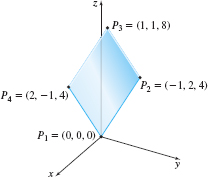EXAMPLE 5Finding the Area of a Parallelogram
Find the area A of the parallelogram shown in Figure 49, which has vertices at the points P1=(0,0,0), P2=(−1,2,4), P3=(1,1,8), and P4=(2,−1,4).
Solution The area A of a parallelogram is ‖, where \mathbf{v} and \mathbf{w} are two adjacent sides of the parallelogram. Be careful! Not all pairs of vertices give a side. For example, \overrightarrow{P_{1}~P_{3}} is not a side; it is a diagonal of the parallelogram. It is helpful to sketch the parallelogram before choosing \mathbf{v} and \mathbf{w}. Choose \begin{equation*} \mathbf{v}=\overrightarrow{P_{1}~P_{2}}= \left\langle -1,\,2,4\right\rangle =-\mathbf{i}+2\mathbf{j}+4\mathbf{k} \end{equation*}
729
and \begin{equation*} \hbox{}\mathbf{w}=\overrightarrow{P_{1}~P_{4}} =\left\langle 2,-1,4\right\rangle =2\mathbf{i}-\mathbf{j}+4\mathbf{k} \end{equation*}
Then \begin{equation*} \mathbf{v}\times \mathbf{w}= \left|\begin{array}{r@{\quad}r@{\quad}r} \mathbf{i} & \mathbf{j} & \mathbf{k} \\[3pt] -1 & 2 & 4 \\[3pt] 2 & -1 & 4 \end{array}\right| =12\mathbf{i}+12\mathbf{j}-3\mathbf{k} \end{equation*}
The area of the parallelogram is \left\Vert \mathbf{v}\times \mathbf{w}\right\Vert = \sqrt{144+144+9}= \sqrt{297} \approx 17.234~\hbox{square units}
